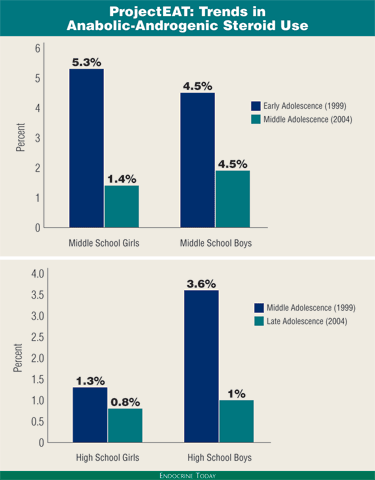Steroid use among adolescents unchanged from 1999 to 2004
Steroid use decreased among adolescents as they got older.
The number of children using steroids did not increase from 1999 to 2004, according to new data from ProjectEAT: Eating Among Teens, a five-year, longitudinal study.
Overall, 1.5% of adolescents reported using steroids.
ProjectEAT is designed to investigate the factors influencing the eating habits of adolescents, to determine if youth are meeting national dietary recommendations and to explore dieting and physical activity patterns and related factors among youth.
Data for the study were collected from 1998 to 1999 and then again from 2003 to 2004. Participants were recruited from public middle and high schools in the Minneapolis area. They completed in-class surveys in 1999 and were mailed follow-up surveys in 2004. There were 1,130 boys and 1,386 girls who completed surveys during both periods. The results were published in Pediatrics.
Anabolic steroid use was reported in 1.4% of girls and 1.7% of boys in the last study year. Of those who reported using steroids, 54% of boys reported having used steroids a few times in the past year; 18% reported having using steroids monthly; 18%, weekly; and 10%, daily. Among girls, 83% of users reported using steroids a few times in the last year; 5%, monthly; 12%, weekly; and none used steroids daily.
Middle school prevalence
The data from this study also indicated that younger boys were almost three times more likely to report steroid use than boys that were in high school. “It is important to note that the highest incidence we saw was in our younger cohort of kids at baseline,” said Patricia van den Berg, PhD, a fellow at the University of Minnesota School of Public Health, in an interview with Endocrine Today. “These were adolescents of middle-school age. It’s a common perception that it’s high school-aged youth who are most at risk, but that may not be the truth of the situation.”
The use of steroids decreased significantly as the participants got older. In addition, steroid use was not very stable over time. Four percent of boys who reported steroid use in 1999 reported continued use of steroids in 2004. Among girls, 11% of steroid users in 1999 reported still using in 2004. However, using steroids in 1999 increased a girl’s odds of using in 2004 by more than 10 times.
“It is encouraging to see that the majority of young people who reported using steroids in 1999 stopped using them as they got older,” van den Berg said in a press release.
 Source: Pediatrics. 2007;119:476-486. |
Reasons for use
The researchers determined that the desire to have an ideal body size and self-report of healthy weight-control behaviors both predicted the use of steroids among boys after the five-year follow-up period. Among girls, a lower satisfaction with weight and a higher BMI predicted steroid use five years later.
“In other words, among boys, those who wanted to weigh more in 1999 were more likely to use steroids later,” van den Berg said. “Among girls however, those who weighed more, were more dissatisfied with their weight, and those who had less knowledge about healthy eating and exercise in 1999 were more likely to use steroids five years later.”
Van den Berg said that girls may view steroids as a way to become more “toned” or “in shape” and therefore thinner. Boys seem to use steroids to increase muscle size and become larger.
“The prevalence in our study … may reflect a shrinking gender gap in adolescent steroid use, although there is some controversy surrounding the validity of recent self-reports of steroid use by girls,” the researchers wrote.
Van den Berg said that one interpretation of these data is that girls are reporting increased steroid use but not actually using more steroids. The increase in girls reporting steroid use could be due to confusion regarding the questions in the survey, she said. Girls could be using corticosteroids found in asthma inhalers or some other substance such as creatine, and reporting this as anabolic or androgenic steroid use. “Our survey asked about using steroids ‘to gain muscle,’ so our participants should not have been confused about asthma medications and other nonanabolic steroids,” she said.
Either way, the difference between the number of girls and boys reporting using steroids is small and further research should be done to understand why, van den Berg said. – by Leah Lawrence
For more information:
- Van den Berg P, Neumark-Sztainer D, Cafri G, Wall M. Steroid use among adolescents: Longitudinal findings from ProjectEAT. Pediatrics. 2007;119:476-486.
